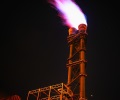
It’s no surprise to see both oil and natural-gas prices finish higher for the month of February as frigid temperatures in the nation’s largest energy-producing state of Texas caused temporary output declines, but natural gas has pulled back significantly and is likely to see further losses in the month ahead.
The extreme cold that covered most of the central and eastern U.S. in mid-February was the biggest reason for the rise in natural-gas prices this month, said Christin Redmond, commodity analyst, energy and sustainability services at Schneider Electric.
The weather delivered “a catastrophic combination of skyrocketing demand for heating and freeze-offs in major production basins,” she said, referring to the phenomenon where ice forms in the cold temperatures and blocks pipelines.
On Feb. 17, the front-month natural-gas contract settled at $3.219 per million British thermal units, the highest since November 2020, according to Dow Jones Market Data.
On Friday, the April natural-gas contract edged down by 0.2% to settle at $2.771 per million British thermal units, but marked a monthly climb of just over 8%.
The winter storms certainly boosted demand temporarily, and the “bump in pricing may stimulate a return to growth projects for gas-directed exploration and production companies, most of which had “gotten very good at slashing costs to the bone over the last year as prices suffered,” said Stewart Glickman, energy equity analyst at CFRA Research.
The February climb for natural-gas prices, however, pales in comparison to the February rise in oil prices. West Texas Intermediate crude futures have seen a monthly climb of nearly 18%.
Crude managed to maintain much of its gains, even as production disruptions tied to the winter storms have eased. Much of the crude rally is linked to supply cuts from the Organization of the Petroleum Exporting Countries and its allies, together known as OPEC+, and optimism tied to COVID-19 rollouts, factors which are “ongoing,” said Redmond.
The disruptions for natural gas have “nearly reverted to normal, with mild temperature outlooks for March providing additional bearishness” for prices, Redmond said.
Energy producers have been recovering from the mid-February freeze and demand for liquid natural gas (LNG) from Asia has also pulled back.
“Key oil and gas producers in the region most affected by the weather — Texas and Oklahoma — have told us that production was out for up to four to five days, but it is being restored completely in the next week or so, if not done already,” said Peter McNally, global sector lead for industrials, materials, and energy at Third Bridge.
Meanwhile, U.S. exports had “effectively doubled” between September and December of last year, he said, but the most recent data show LNG exports have “abated starting in early February,” on the back of easing demand, particularly in Asia.
And seasonally, the market sees inventories build in April as moderate temperatures normally experienced in the spring dull heating and power demand, said McNally.
“The bottom line is that we are at the tail end of the peak demand season for natural gas,” and the “best of demand is in the rear view mirror,” he said.
Source: MarketWatch
"gas" - Google News
March 01, 2021 at 03:00AM
https://ift.tt/3e194m5
Why natural-gas prices underperformed oil prices in February by a long shot - Hellenic Shipping News Worldwide
"gas" - Google News
https://ift.tt/2LxAFvS
https://ift.tt/3fcD5NP
Bagikan Berita Ini















0 Response to "Why natural-gas prices underperformed oil prices in February by a long shot - Hellenic Shipping News Worldwide"
Post a Comment